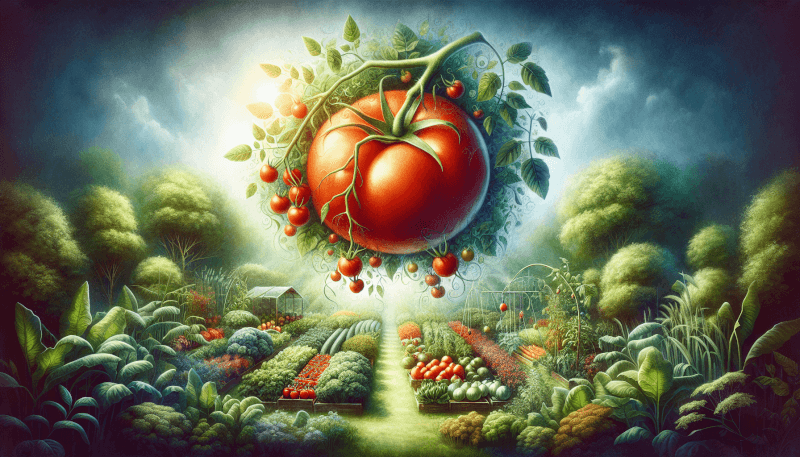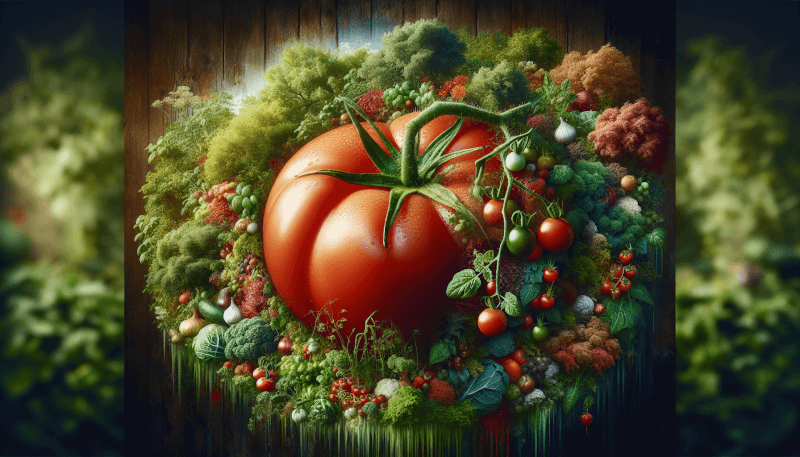Are you looking for delicious recipes that prioritize freshness and health? Look no further! “Garden to Table: Fresh and Healthy Recipes” is your ultimate guide to creating mouthwatering meals using ingredients straight from your garden. This article will explore a variety of simple and nutritious recipes that will leave you feeling satisfied and nourished. Get ready to embark on a culinary adventure that celebrates the vibrant flavors of fresh produce and unlocks the true essence of farm-to-table dining.

Benefits of Garden to Table Cooking
Garden to table cooking has become increasingly popular in recent years, and for good reason. There are numerous benefits to incorporating fresh produce from your garden into your meals. Not only does it provide access to the freshest ingredients possible, but it also reduces the use of harmful pesticides and enhances the nutritional value of your food.
Access to Fresh Produce
When you grow your own garden, you have the advantage of having immediate access to fresh produce. You can simply step outside, pick the vegetables and herbs that you need for your meal, and immediately start cooking. This ensures that you’re consuming the freshest food possible, as it hasn’t been sitting in transit or on store shelves for days.
Reduced Use of Pesticides
By growing your own garden, you have control over what pesticides, if any, are used on your plants. Many commercially grown fruits and vegetables are sprayed with harmful chemicals to combat pests and diseases. By eliminating or reducing the use of pesticides in your garden, you can minimize your exposure to these harmful substances.
Enhanced Nutritional Value
Freshly harvested produce contains higher levels of vitamins and minerals compared to store-bought produce. As soon as fruits and vegetables are picked, their nutrient content begins to decline. By consuming them right after they are picked, you are ensuring that you’re getting the maximum nutritional value from your food.
Garden Planning and Maintenance
To successfully embark on a garden to table cooking journey, it’s important to start with proper planning and maintenance of your garden.
Choosing the Right Vegetables and Herbs
One of the first steps in garden planning is selecting the right vegetables and herbs to grow. Consider the climate and soil conditions in your area, as different plants thrive under different conditions. It’s also important to choose plants that you and your family enjoy eating. This way, you’ll be more excited about cooking with your garden produce.
Preparing the Garden Bed
Prepare the garden bed by removing any weeds and grass and loosening the soil. Ideally, you should amend the soil with compost or organic matter to provide nutrients for the growing plants. This will ensure that your vegetables and herbs have a healthy and nutrient-rich environment to grow in.
Planting and Caring for the Garden
Once the garden bed is prepared, it’s time to plant your chosen vegetables and herbs. Be sure to follow the planting instructions for each specific plant, as they may have different spacing and care requirements. Additionally, regular watering, weeding, and pest management are crucial to ensure healthy and thriving plants.

Harvesting and Storing Garden Produce
Knowing when to harvest your garden produce is essential to getting the best flavor and texture out of your vegetables and herbs.
Knowing When to Harvest
Each vegetable and herb has its own signs of readiness for harvest. Research the specific plants you are growing to learn what to look for. In general, vegetables are usually harvested when they are fully mature, while herbs can be harvested throughout the growing season as needed.
Proper Methods of Harvesting
It’s important to use the proper methods when harvesting your garden produce to prevent damage to the plants. For most vegetables, using a sharp knife or pruning shears to cut them from the plant is the best method. Herbs can be harvested by plucking individual leaves or cutting entire stems, depending on the plant.
Storing and Preserving Garden Produce
To prolong the freshness of your garden produce, proper storage and preservation techniques are key. Some vegetables can be stored in the refrigerator, while others may require blanching and freezing. Herbs can be preserved by drying or freezing them in oil or water. By properly storing and preserving your garden produce, you can enjoy its freshness for months to come.
Garden to Table Recipes
Now that you have successfully grown and harvested your own garden produce, it’s time to put them to good use in delicious and healthy recipes.
Fresh Garden Salad
A fresh garden salad is a classic way to showcase your homegrown vegetables. Combine a variety of leafy greens, such as lettuce or spinach, with sliced cucumbers, cherry tomatoes, and any other vegetables you have on hand. Top it off with a homemade dressing made with herbs from your garden for a truly garden-fresh experience.
Roasted Vegetable Medley
Roasting a medley of vegetables brings out their natural sweetness and flavors. Toss together your favorite garden vegetables, such as carrots, bell peppers, zucchini, and onions, with some olive oil, salt, and pepper. Roast them in the oven until they are tender and slightly caramelized. Serve as a side dish or add them to pasta or grain dishes for a hearty and nutritious meal.
Herb-infused Pasta
Fresh herbs can take a simple pasta dish to the next level. Cook your favorite pasta according to the package instructions and toss it with a mixture of sautéed garden vegetables, such as cherry tomatoes and garlic. Finish it off by adding freshly chopped herbs, such as basil, parsley, or cilantro, for a burst of freshness.
Tomato and Basil Bruschetta
Bruschetta is a versatile and refreshing appetizer that highlights the flavors of tomatoes and basil. Toast slices of crusty bread and top them with a mixture of diced tomatoes, chopped fresh basil, minced garlic, olive oil, balsamic vinegar, salt, and pepper. It’s a perfect way to use up an abundance of fresh garden tomatoes.

Cooking Techniques for Garden Freshness
To retain the freshness and flavor of your garden produce, it’s important to use cooking techniques that require minimal processing.
Minimal Processing
To preserve the flavors and nutritional value of your garden produce, opt for minimal processing methods. Avoid overcooking vegetables, as this can cause them to become mushy and lose their vibrant colors and flavors. Instead, lightly steam or sauté them to retain their natural texture and taste.
Blanching and Freezing
If you find yourself with an abundance of garden produce, blanching and freezing can be a great way to preserve them for future use. Blanching involves briefly boiling vegetables in hot water and then immediately transferring them to an ice bath to stop the cooking process. Once blanched, the vegetables can be packed into freezer bags or containers and stored in the freezer for several months.
Preserving Herbs in Oil
To prolong the life of your fresh herbs, preserve them in oil. Simply chop the herbs and place them in an ice cube tray, then fill each compartment with olive oil. Freeze the tray until the oil solidifies, then transfer the herb-infused oil cubes to a freezer bag. Whenever you need herbs for cooking, simply pop a cube or two into your dish for an instant burst of flavor.
Plant-based and Nutrient-rich Meals
Garden to table cooking is a great way to incorporate more plant-based and nutrient-rich meals into your diet. Here are a few recipes to inspire you:
Vegetable Stir-Fry with Tofu
In a hot pan or wok, sauté a variety of vegetables, such as bell peppers, broccoli, carrots, and snow peas, with a little oil and soy sauce. Add tofu for a complete protein source and serve over rice or noodles for a filling and nutritious meal.
Quinoa Stuffed Bell Peppers
Cut the tops off bell peppers and remove the seeds. Fill the peppers with cooked quinoa mixed with sautéed vegetables, such as onions, tomatoes, and zucchini. Bake in the oven until the peppers are tender and the filling is heated through. This dish is packed with fiber, vitamins, and minerals.
Chickpea and Kale Curry
Sauté onions, garlic, and spices in a large pot until fragrant. Add chopped kale, chickpeas, diced tomatoes, and vegetable broth. Simmer until the kale is tender and the flavors have melded together. Serve with rice or naan bread for a delicious and satisfying plant-based meal.

Tips for Flavorful Garden to Table Cooking
To take your garden to table cooking to the next level, consider these tips for adding flavor and variety to your meals:
Using Fresh Herbs and Spices
Fresh herbs and spices can elevate the taste of any dish. Experiment with different combinations of herbs, such as rosemary, thyme, and sage, to add depth and complexity to your recipes. Don’t be afraid to experiment and find your own signature flavor profiles.
Experimenting with Different Vegetable Combinations
Don’t limit yourself to traditional vegetable pairings. Mix and match different vegetables to create unique and interesting flavor combinations. For example, try combining sweet potatoes with Brussels sprouts or beets with orange segments for a surprising twist.
Enhancing Flavors with Homemade Dressings and Sauces
Instead of store-bought dressings and sauces, create your own at home using fresh garden ingredients. Blend herbs, garlic, olive oil, and vinegar for a flavorful salad dressing. Puree roasted vegetables with spices for a savory sauce to accompany your main dishes. Homemade dressings and sauces allow you to control the flavors and ingredients, resulting in a more personalized and delicious end product.
Incorporating Garden Produce into Baked Goods
Don’t underestimate the versatility of your garden produce. Fruits and vegetables can also be incorporated into baked goods for a fun and nutritious twist.
Zucchini Bread
Grated zucchini adds moisture and a subtle sweetness to breads and muffins. Try adding grated zucchini to your favorite bread recipe, along with spices like cinnamon and nutmeg, for a moist and flavorful treat.
Carrot Muffins
Carrots are another vegetable that can be grated and added to baked goods. Carrot muffins, spiced with cinnamon and topped with cream cheese frosting, are a delightful way to enjoy the natural sweetness and vibrant color of carrots.
Pumpkin Pie
If you’re lucky enough to have grown pumpkins in your garden, making a homemade pumpkin pie is a must. Puree the cooked pumpkin flesh, mix it with spices like cinnamon, ginger, and nutmeg, and pour it into a homemade or store-bought pie crust. Bake until set and golden, and enjoy a slice of homemade goodness.

Garden to Table for Kids
Involving children in the garden to table experience can be both educational and fun. Here are some tips for getting kids excited about growing and cooking their own food.
Getting Kids Involved in the Garden
Give children their own space in the garden to grow vegetables and herbs of their choice. Let them participate in planting, watering, and caring for their plants. This will instill a sense of responsibility and pride in their own garden plot.
Kid-friendly Garden-to-Table Recipes
Introduce kids to the joys of cooking by involving them in simple and kid-friendly garden-to-table recipes. Start with something easy, like a fresh garden salad or homemade salsa. As their skills and confidence grow, you can move on to more complex recipes together.
Teaching Children About Healthy Eating
Use the garden to teach children about the importance of healthy eating. Explain how fruits and vegetables are nutritious and good for their bodies. Show them how their hard work in the garden can result in delicious and healthy meals. Encourage them to try new vegetables and flavors to expand their palate and promote healthy eating habits.
Conclusion
Embracing a garden-to-table lifestyle offers numerous benefits, from access to fresh produce to enjoying fresh and healthy meals. By taking the time to plan and maintain your garden, properly harvest and store your produce, and experiment with delicious recipes, you can create a culinary experience that is not only nutritious but also incredibly satisfying. So, grab your gardening tools and cooking utensils, and start reaping the benefits of garden to table cooking today. Your taste buds and your body will thank you.

